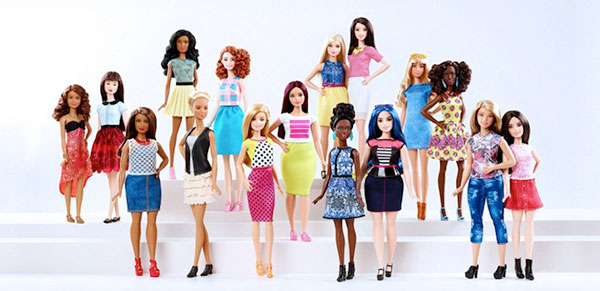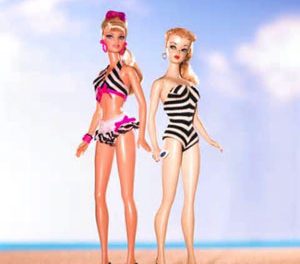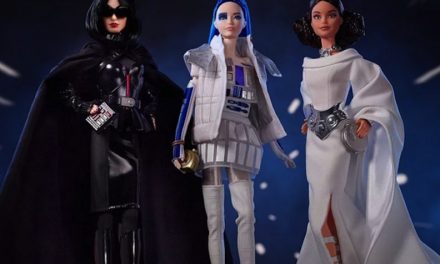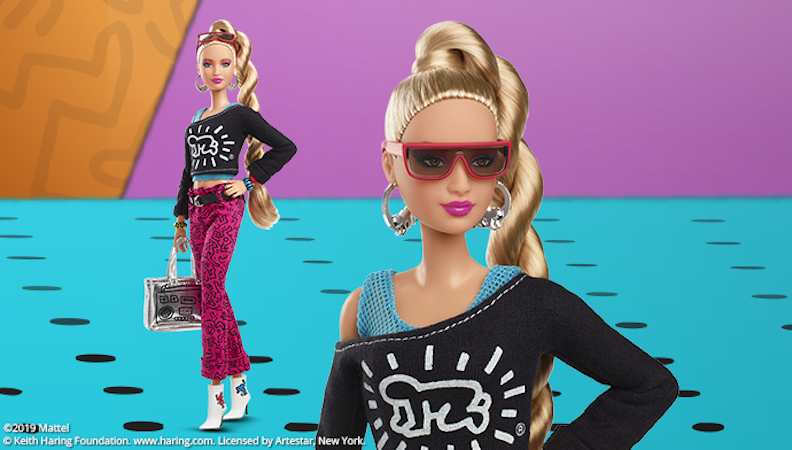
Mattel’s Keith Haring X Barbie strikes a pose.
The 1980s, right up to the edge of 1990, have become very attractive to the Instagram generation. From Netflix’s “Stranger Things” to FX’s “Pose,” audiences can’t get enough of the decade that toppled the Berlin Wall but saw the rise of AIDS, elected Reagan twice to the White House and welcomed Bon Jovi to rock royalty. It was a time of conservative talking points and excessive pop-culture partying. During this crucial decade, graffiti moved from the subway and streets to the most upscale galleries. American artist Keith Haring was one of these young movers-and-shakers, and his seemingly simple doodling launched a movement. This past spring, Mattel paid tribute to his legacy with the Keith Haring X Barbie doll.

Keith Haring never wanted to make art that simply hung on museum walls. Subway walls were his first galleries.
It’s quite exciting to see a fashion doll decked out in recognizable, iconic Keith Haring designs. Born in Reading, Pennsylvania, in 1958, he exhibited great talent and drive from an early age. Circulating in and out of school — a classroom wasn’t really his scene — Haring made cash by producing Grateful Dead T-shirts. He was quick to see the connection between so-called “crass commerce” and artistic marketing.
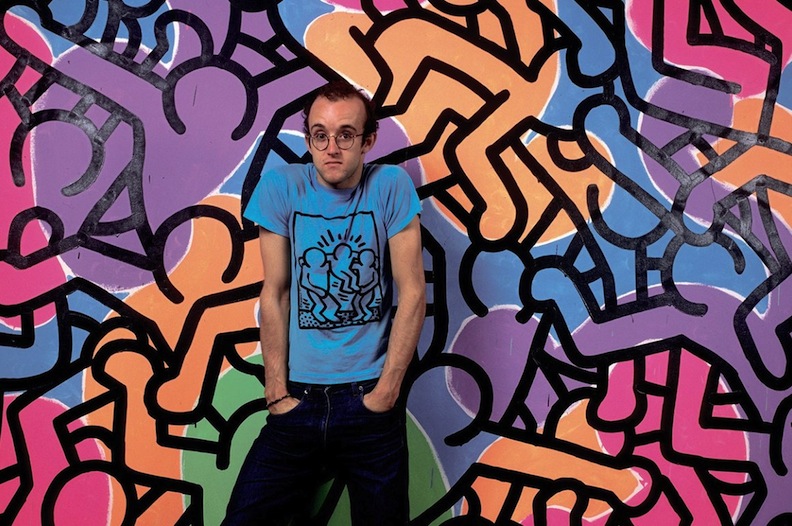
A man of the people? Keith Haring’s life was a brief one, and he used his art for commerce and social commitment.
Heading to New York City, at age 20, he enrolled briefly at the School of Visual Arts (SVA). He supported himself as a busboy, waiting and clearing tables at the Danceteria nightclub. Haring didn’t complete his degree, but he did pick up an insight that literally colored all of his future work. He studied semiotics at SVA, where he learned the impact that signs, symbols, analogies, allegories, and communications have on the public. This connection between a visible cue and an invisible reaction guided Haring’s artwork. He began to use blank blackboards in New York’s train stations as his canvas. The empty frames, where ads were going to be inserted, became his proving ground. Keith Haring made that connection between his illustrations and commercialization. He knew he could get eyes upon his work, and eyes meant an interested audience and potential sales.

The Keith Haring X Barbie does have a Madonna/”Desperately Seeking Susan” vibe to it.
Keith Haring is an interesting artist because he clearly understood the tie-in between limited output and higher asking prices. Even though he comprehended this, and wanted to make money, he also wanted folks of limited means to own and know about his work. He was a strong supporter of popularity and populism. Haring stressed the “pop” in pop art and pop culture. To him, it meant the population having a share of his creations.
As Keith Haring’s graffiti became more and more sought after, and he was commissioned to execute his work around the world, he always made sure to have collectibles manufactured with his iconic handiwork on it. He oversaw his artwork translated into T-shirts, posters, key chains, and 3-D figures that average people could own.
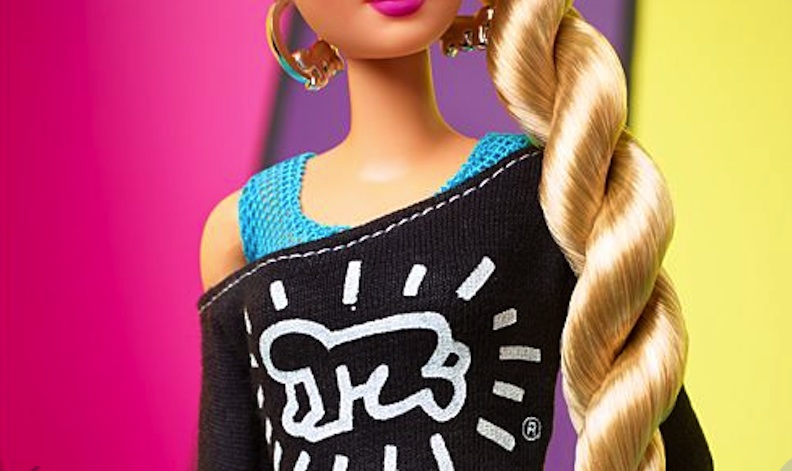
The iconic “Radiant Baby” crawls across Barbie’s sweatshirt.
Haring’s most famous artwork includes the “Radiant Baby,” the “Bueprint Drawings” series, the barking dog icons, and the dancing figures. Many of these colorful images are jubilant, filled with happiness and joy. Others are highly sexualized and political. Living life as an openly gay man, Haring did not shy away from his identity. In fact, one of his drawings has become the go-to image for Coming Out Day. Tragically, after years of advocacy and consciousness-raising for safe sex, Keith Haring was diagnosed with AIDS. It was his death sentence.
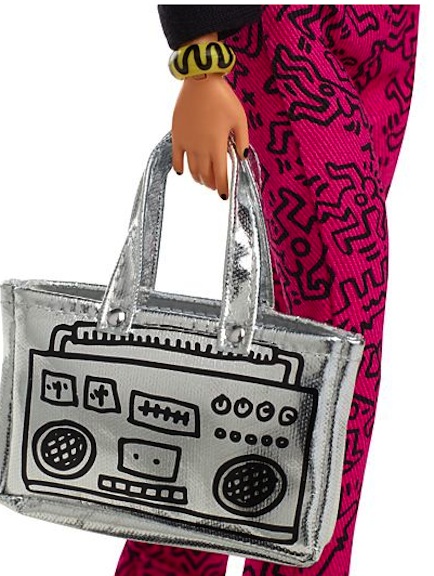
Boomboxes were all the rage in the 1980s. They were a must-have accessory. Here, it doubles as a pocketbook.
During his brief lifetime — he passed away at age 31 in 1990 — he influenced gallery owners, other artists, art critics, and musicians. An aspiring dancer/musician who headed to New York City from Michigan became one of his closest friends. Young Keith Haring and equally young Madonna Ciccone became thick as thieves. They were fast friends during these fast and furious times. Madonna often wore outfits decorated with his recognizable silhouettes and shapes as she climbed the showbiz ladder. On England’s “Top of the Pops” TV show and America’s “Solid Gold,” Madonna wore a Keith Haring original while she lip-synched to her own recording of “Like a Virgin.”
The Mattel Keith Haring X Barbie doll has a Madonna allure. The fashion doll’s face is the Goddess sculpt, but her confidence and charisma seems to be 100% Ciccone. Designed by Bill Greening for the Gold Label imprint, the Barbie looks like she just stepped out of a Haring exhibition. The doll wears a mesh tank and an off-the-shoulder sweatshirt emblazoned with the “Radiant Baby.”
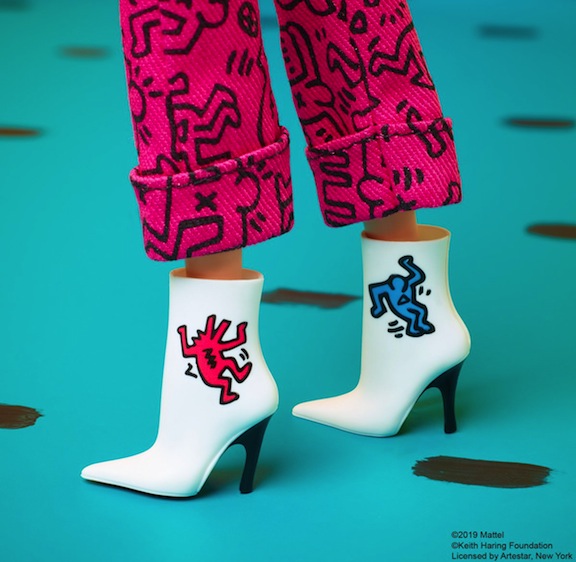
Keith Haring’s signature dancing figures accentuate Barbie’s boots.
Cleverly turning the doll into a walking Keith Haring billboard, Greening designed her boots as pure 1989 dreaminess. The fabled dancing figures bust their moves on her stiletto boots with black soles. Her bracelets and jewelry are thick, chunky baubles, and her handbag is a silver boombox. The Keith Haring X Barbie doll is identical to the young women who were breezing through the East Village art and music scene. She is an ambassador from a heady and exhilarating time that was both brief and enduring. Apparently, she maxed out her credit card at Haring’s own Pop Shop.
As we all know, the fearlessness of the 1980s became a more vigilant and wary 1990s. This doll is marked by confidence. She also is paired with a doll sketch, evoking a cool artist’s draft.

This artist’s sketch by Bill Greening reveals how the Keith Haring X Barbie came to fruition.
Before Haring’s demise in 1990, he founded the Keith Haring Foundation in 1989. Its purpose: “to provide funding and imagery to AIDS organizations and children’s programs.” The foundation provides grants and financial assistance to AIDS education programs and art classes for disadvantaged and economically challenged youth. This year marks the foundation’s 30th anniversary.
Additionally, June 2019 marked the 50th anniversary of the Stonewall uprising. Haring’s work was included in worldwide museum exhibitions that celebrated LGBTQ pride. He was inducted into a Hall of Fame for LGBTQ artists and allies who have made a difference over the past half-century.
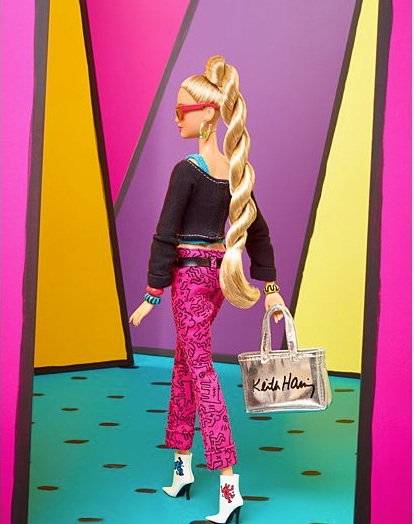
Throughout his life, Keith Haring made a difference. He influenced pop art, pop music, and the population.
When he was alive, Keith Haring lived every day. He networked, name-dropped, made art, and made a difference. Haring became a close and trusted confidant to Grace Jones, whom he body-painted for multiple performances. He befriended Andy Warhol, one of his artistic influences. His widening social circle included a who’s who of 1980s stars and influencers: Jean-Michel Basquiat, Kenny Scharf, Roy Lichtenstein, Boy George, and Yoko Ono.
Over the past 30 years, Haring’s foundation has worked to ensure his legacy continues to flourish and survive. It also labors to keep a spotlight on the successes and struggles of his onetime peers and pals.
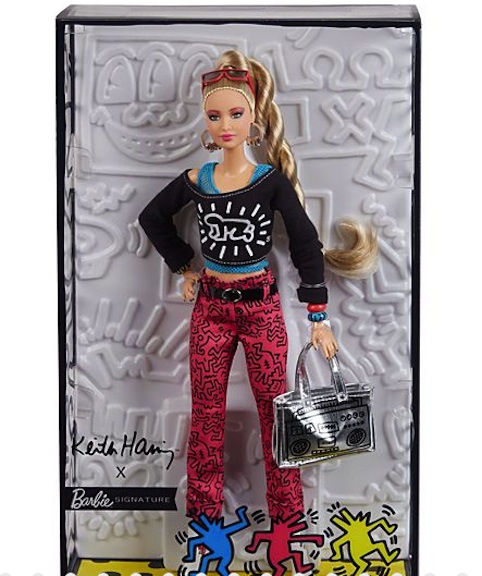
The Barbie Signature box is also a work of art.
The Mattel Keith Haring X Barbie evokes a long-ago time that continues to fascinate and mesmerize. TV shows exemplify how today’s kids connect with the rule breaking and the status quo-shaking achievements. This new Barbie doll radiates the carefree attitude that covered up the real-world cares and worries. The downside to the 1980s would curtail many lives, and would underscore the survivors’ future decisions.
Keith Haring X Barbie says a lot, without saying a single word. For an artist who believed his art belonged in people’s hands, this is a fitting, surprising hands-on tribute.

